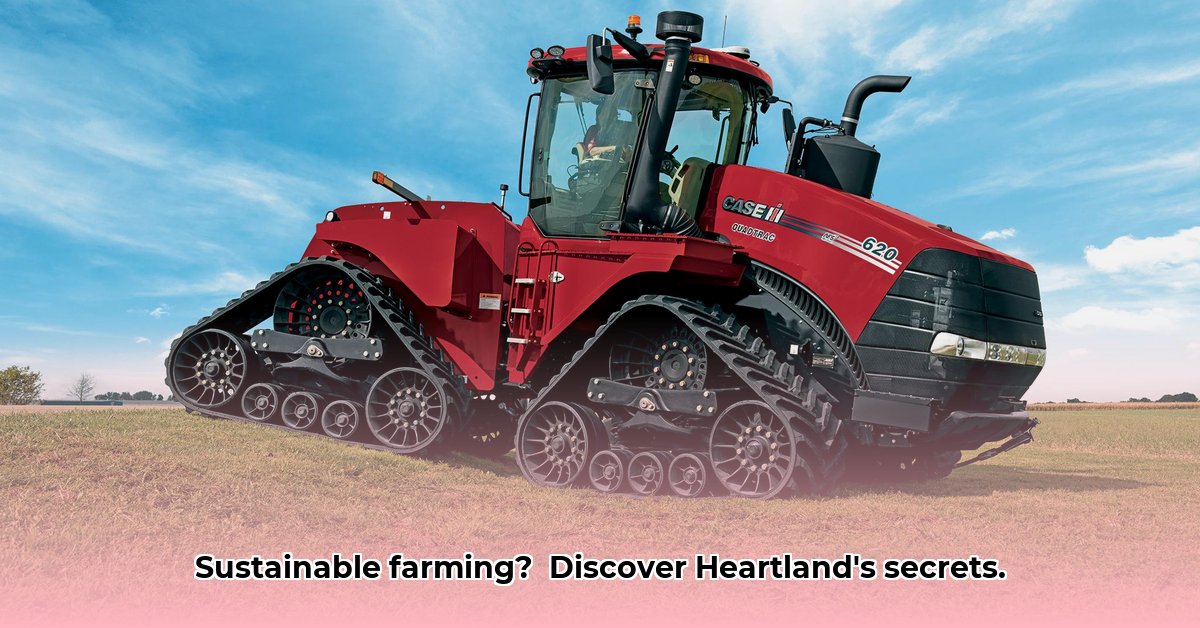
Heartland Tractor, a prominent agricultural equipment dealer in Harrisonville, Missouri, serves farmers across Missouri and Kansas. While renowned for customer service and equipment maintenance, its commitment to sustainable farming practices requires further examination. This case study analyzes Heartland's current approach, identifies areas for improvement, and proposes a roadmap for integrating sustainability into its core business strategy. Learn more about Heartland Tractor's services by visiting their website: Heartland Tractor.
Heartland Tractor and Sustainable Practices: A Critical Analysis
Heartland Tractor's primary focus currently centers on maximizing farmer profitability. While this is a form of sustainability, a deeper dive reveals a lack of readily available public information regarding their environmental impact. Questions remain unanswered concerning their contributions to mitigating greenhouse gas emissions, conserving water resources, and collaborating with organizations dedicated to sustainable agriculture. This lack of transparency presents a significant opportunity for improvement. How effectively is Heartland Tractor incorporating sustainable practices into its business model? This is a crucial question for both the company and the farming community.
What Heartland Can Do to Promote Sustainable Agriculture: A Strategic Roadmap
To solidify its position as a leader in sustainable agriculture, Heartland Tractor must adopt a proactive, multi-faceted strategy. This plan outlines key short-term and long-term goals designed to enhance environmental performance and reinforce its commitment to sustainable farming.
Short-Term Goals (Within the Next Year):
Conduct a comprehensive environmental impact assessment: A rigorous assessment of Heartland's carbon footprint, including fuel consumption, waste management, and supply chain emissions, is needed to establish a baseline for improvement. This data will be crucial for setting realistic targets and measuring progress.
Publicize existing sustainability efforts: Transparent communication about existing efforts, such as the use of fuel-efficient equipment or recycling programs, will build trust and attract environmentally conscious customers. This transparency builds credibility and showcases their commitment.
Long-Term Goals (Over the Next 3-5 Years):
Invest in research and development of sustainable technologies: Exploring and promoting alternative fuels (biofuels, electricity, hydrogen fuel cells) for agricultural machinery represents a substantial step towards reducing carbon emissions. This long-term investment demonstrates a vision for a greener future.
Forge strategic partnerships: Collaborating with organizations focused on sustainable agriculture will expand access to expertise, resources, and best practices, accelerating the adoption of environmentally conscious farming methods. These partnerships enhance credibility and innovation.
Develop a comprehensive carbon reduction plan: A plan encompassing all aspects of Heartland’s operation, from equipment sales to facility energy consumption, is essential to systematically reduce the company's overall environmental impact. This ensures accountability and consistent progress.
Farmers: Essential Partners in a Sustainable Future
Farmers are integral to the transition towards sustainable agriculture. Short-term actions include optimizing equipment maintenance for fuel efficiency and exploring financing options for sustainable technologies. Long-term strategies involve embracing precision farming techniques to optimize resource use and diversifying crops to enhance resilience. Investing in renewable energy sources, such as solar panels, further strengthens their commitment to a sustainable future. "Farmers need to embrace innovative techniques to thrive long-term," states Dr. Emily Carter, Agricultural Economist at the University of Missouri.
The Role of Government Support: Catalyzing Change
Government agencies in Missouri and Kansas play a vital role in supporting the shift towards sustainable farming. Short-term actions could include offering financial incentives for adopting sustainable practices and funding research into sustainable agricultural technologies. Long-term strategies necessitate supportive policies and readily accessible technical assistance for farmers to successfully transition to sustainable agricultural methods. This collaborative approach is vital for widespread adoption.
Assessing the Risks: A Proactive Approach
Transitioning to more sustainable agriculture involves inherent risks. Proactive risk management is essential:
| Risk Factor | Likelihood | Impact | Mitigation Strategy |
|---|---|---|---|
| Reliance on fossil fuels | Very Likely | Significant | Transition to alternative fuels (biofuels, electricity, hydrogen); research and development of sustainable alternatives. |
| Climate change impacts on crops | Very Likely | Significant | Promote drought-resistant crop varieties; invest in water-efficient irrigation techniques; implement crop diversification strategies. |
| Changes in regulations | Likely | Moderate | Closely monitor and adapt to evolving environmental regulations; engage with regulatory bodies. |
| Disruptions to the supply chain | Possible | Moderate | Diversify sources for parts and materials; build stronger relationships with suppliers; explore domestic sourcing. |
How to Reduce Fuel Consumption on Farm Equipment in Missouri: Practical Strategies
Rising fuel costs directly impact farm profitability. Employing strategies to optimize fuel efficiency is crucial:
Maintenance Matters: The Foundation of Fuel Efficiency
Regular maintenance is paramount for maximizing fuel efficiency. This includes scheduled engine servicing, maintaining proper tire pressure, and ensuring a clean fuel system to enhance combustion efficiency. Neglecting these aspects leads to increased fuel consumption and potential breakdowns.
Operational Optimization: Smart Practices, Smart Savings
Operating techniques significantly influence fuel economy. Employing the correct gear for the task, minimizing idling, and proper ballasting all contribute to fuel savings. These simple yet effective strategies yield substantial long-term benefits.
Technology and the Future of Fuel Efficiency
Precision agriculture technologies, such as auto-steer systems and variable-rate technology, enhance efficiency by reducing overlaps and optimizing input application. While initial investments are substantial, long-term fuel savings justify the expense.
Heartland Tractor's Role in Fuel Efficiency
Heartland Tractor can play a pivotal role by providing advice, training, and access to fuel-efficient equipment, empowering farmers to enhance their fuel efficiency practices.
Considering Premium Fuels: A Cost-Benefit Analysis
Premium diesel fuels offer potential fuel savings; however, a detailed cost-benefit analysis is crucial to determine their appropriateness for individual farming operations. The balance between increased performance and higher upfront costs should be carefully examined before widespread adoption.